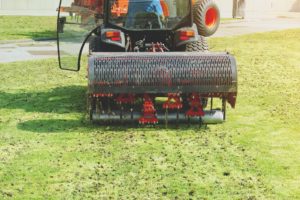
August lawn care includes tasks like aeration, which relieves soil compaction.
As summer begins to wind down in August, you may believe that lawn care responsibilities wind down as well. However, August is a crucial month for lawn care. During this month, you need to maintain the look of your lawn while preparing for winter dormancy. If you want to maintain the beauty and health of your landscape, practice these components of August lawn care with Scientific Plant Service.
Test Your Soil Nutrients and Apply Fertilizer
It is always a good practice to test your soil for pH and nutrient levels. Any soil deficiency will prevent your lawn from growing to its full potential. Maintaining adequate soil nutrient levels is important to prepare your lawn for the next growing season. In late summer and fall, your lawn is storing carbohydrates and building a strong root system for next year’s growth. By fertilizing your lawn, you provide the necessary supply of these nutrients that promotes a strong root system. Because cool season grasses grow at a faster rate in the upcoming months, fertilizing at the end of summer is essential.
Aerate Your Lawn
All of the time spent out on your lawn this spring and summer may have led to compaction. When soil is compacted, grass roots have difficulty penetrating and growing. They don’t receive the air, water, and nutrients they need. This is why aeration is a key part of lawn care in August through fall. A core aeration machine pulls soil cores out, opening holes in the soil to relieve compaction. The cores pulled out are distributed on the lawn, where they will topdress the soil surface and help combat thatch.
Stop Thatch Issues
Thatch is dead plant material found between growing grass and the soil underneath. It is light brown and may look inactive at first glance. However, moderate thatch is full of microorganisms beneficial for healthy plant growth. Those organisms make their home in the decaying parts of the grass and create the interwoven mat you see when you look closely.
If your lawn’s thatch is less than half an inch thick, there’s nothing to worry about. However, if the layer of thatch is thicker, you will want to use a dethatching or vertical mower to remove those excess materials that can hinder air and water movement into your soil.
Start Overseeding Your Lawn
It is always a good practice to incorporate new and improved turf varieties into your lawn. By overseeding with the current proven varieties recommended by the University of Maryland or Virginia Tech you will give your lawn the best opportunity to thrive. August through fall is the best time of year to overseed. Moderate temperatures and less competition from annual weeds provide the ideal environment for seed germination and growth. As you overseed, it’s crucial to work the seed into the soil. Most seeding failures are due to not providing good seed/soil contact.
Overseeding works best when your lawn is not too compact, so aeration may be best beforehand. Keep the sprouting seeds damp; new seedlings cannot be allowed to desiccate.
August lawn care is essential for building your lawn’s root system for a strong and vigorous lawn in the months and years ahead.
Scientific Plant Service Is Your Go-To Source In Landscape Healthcare
Scientific Plant Service, located in Baltimore, is a privately owned corporation, chartered in Maryland in 1957 by Frank J. Burke. We started as a full-service Arborists specializing in the care of shade trees and ornamental shrubs, but today we are a Lawn Care company that is a huge part of the community. From aquatic environments and snow management to deer and mole control, SPS has services tailored specifically for your lawn and landscape.
We offer services in Maryland, Washington, DC, and Virginia, including: Harford, Baltimore, Carroll, Frederick, Howard, Anne Arundel, Montgomery, Prince Georges, Talbot, Queen Anne’s, Calvert counties in MD, as well as Loudoun County, Fairfax County, Arlington, Alexandria, and Falls Church in VA. For more information, contact us online, or call us at 410-321-0970. Be sure to follow us on Facebook, Twitter, LinkedIn, and Pinterest.

